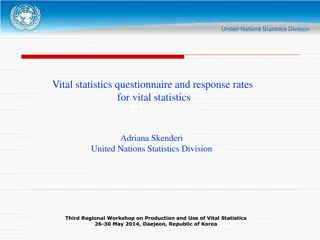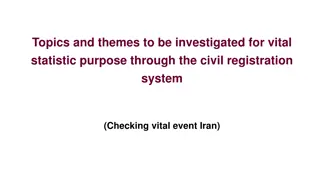Comprehensive Overview of Civil Registration and Vital Statistics System
This presentation provides an in-depth look at the Civil Registration and Vital Statistics (CRVS) system in a specific country. It covers types of vital records collected, the CRVS structure, legal requirements, processing of registered records, content of birth and death certificates, and obtaining cause of death information. The detailed analysis aims to showcase the importance, functioning, and legal aspects of the CRVS system.
Download Presentation

Please find below an Image/Link to download the presentation.
The content on the website is provided AS IS for your information and personal use only. It may not be sold, licensed, or shared on other websites without obtaining consent from the author. Download presentation by click this link. If you encounter any issues during the download, it is possible that the publisher has removed the file from their server.
E N D
Presentation Transcript
The Civil Registration and Vital Statistics System in Country Names & Titles of Presenters
Types of Vital Records List all of the official types of vital records collected in your country (e.g. birth, death, marriage, divorce, adoptions, etc.). Indicate (on slide or verbally during the presentation) the purpose of each type of record collected. Why does the country collect this information? What can we learn from this information?
CRVS Structure Include a diagram of the civil registration structure in your country. The diagram should (if possible): List specific agencies where CRVS functions are located (i.e. the place of registration of vital events in your country) List the format for collection of vital event information Show how birth and death certificates are issued List the type of storage used for vital event records Highlight areas where computerization is used
Legal Requirements Briefly list/summarize the country s specific legal requirements for its CRVS system and for protecting confidentiality. Points to cover: What are the registration requirements that apply to the entire country? What are the time requirements for registering? List the required informant for registering vital events Are there penalties for not complying with the law? What are the requirements for publishing vital statistics? *Bring a copy of the legal requirements to be discussed in the training course.
Registered Records Provide a flow chart showing how records are processed in your country. Include the process for: How records are numbered and coded Editing and querying vital records How records are corrected
Registered Records: Content of Certificates Provide a brief description of the content of the birth and death certificates in your country- do they follow WHO guidelines? * Bring examples of certified copies of records from your country to be used for discussion during the course. * Bring a list of definitions used for vital events in your country to compare and discuss during the course.
Cause of Death Briefly summarize how cause of death is obtained in your country (bring an example of the medical certification form if it is used). How are causes of death classified in your country? Is the ICD system used in your country? How often are the ICD codes revised? What version is currently used in your country? Are data tabulated using lists recommended by WHO? If fetal deaths are reported in your country s CRVS system, describe what the requirements are for reporting fetal deaths and what information is collected.
Statistics Natality: what types of natality/birth statistics are produced/ used in your country? Mortality: what types of mortality statistics are produced/used in your country?
Publications & Data Use List the types of vital statistics publications that are produced in your country. *Please bring paper copies of vital statistics reports to share and discuss during the course. If applicable, list special uses of vital statistics data (e.g. research, social security, commercial uses, etc.). List professional or technical meetings that are hosted to help users better understand the country s vital statistics data.
Challenges in CRVS List what geographic areas and population groups exist in your country. Do any of these groups present registration or reporting challenges?
Coverage List coverage information for your country. What areas are covered or not covered (e.g. urban, rural, certain regions)? What populations are covered or not covered? If known, list the coverage of vital events in your country.
Accuracy of Vital Statistics List the following for your country, if known (use the most recent data year available): Missing data % of key variables with no response % of cause of death reports with missing age/sex Erroneous data Response error: % responses classified as unknown Methods used for matching sample of reports with independent records? Coding error: is double coding conducted?
Accuracy of Vital Statistics (cont d) List the following for your country, if known (use the most recent data year available): Use of ill-defined categories % of deaths classified as miscellaneous/ill-defined Is this < 25% unknown (ideal)? Improbable classifications # deaths assigned improbable age/sex per 100,000 coded deaths
Timeliness of Vital Statistics Data List the following, if known (use the most recent year for which data are available): % of events that occurred in previous years Production time: mean time from end of reference period to publication Regularity: standard deviation (SD) of production time Was there a delay in the release of the national file? If yes, for how long? Were reports published without delayed records?
CRVS System Improvement Efforts Describe any efforts that have been taken to improve the CRVS system in your country.
Additional Information Add any additional information that you feel is important about your country s civil registration and vital statistics system























